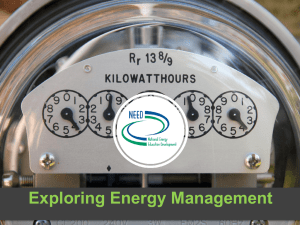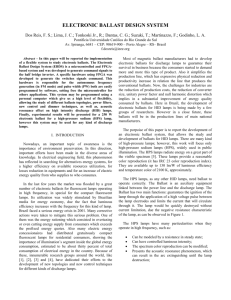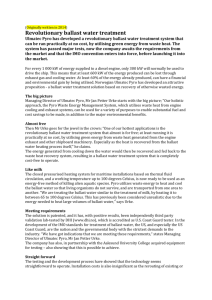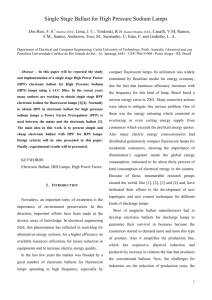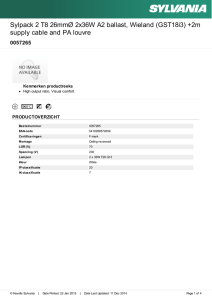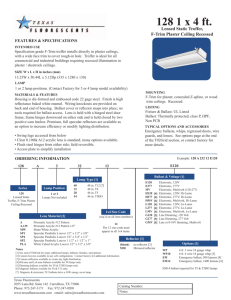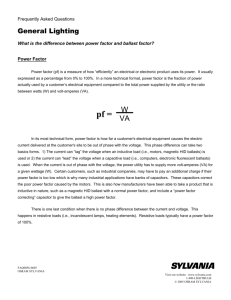Electronic Ballast Fundamentals
advertisement
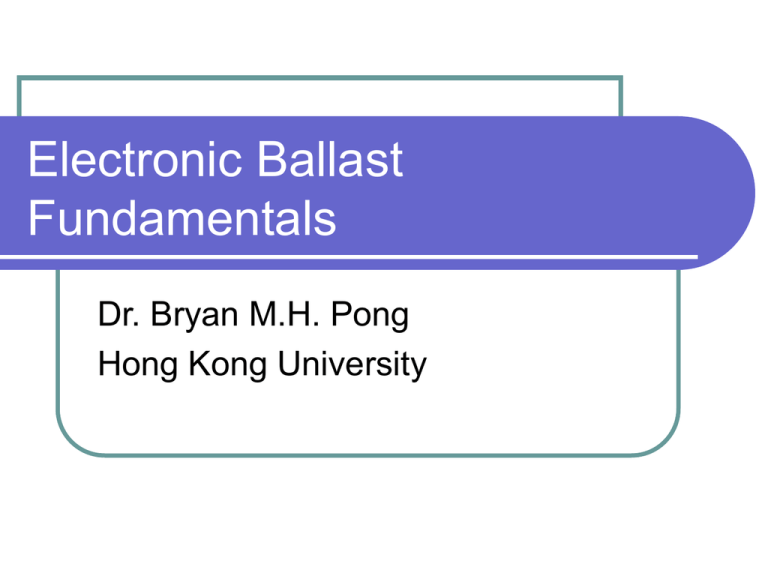
Electronic Ballast Fundamentals Dr. Bryan M.H. Pong Hong Kong University Fluorescent tubes Much more efficient than incandescent lamps : 2 to 4 times more efficient The lamps last a lot longer – 10k to 20k hours versus 0.75k to 1k hours for an incandescent lamp The lamps are much cooler than incandescent lamps Lamp structure The lamp is a sealed tube containing mercury vapor and some inert gases such as argon at very pressure The inside of the tube is coated with phosphor At the ends of the tube there are filaments or electrodes Lamp structure http://home.howstuffworks.com/ How does it work? When the tube is off it does not conduct It is turned on by a high voltage which excites the gas inside the tube Once the tube conducts on a lower voltage is sufficient to maintain conduction The electric current passes through the gas and emits UV, the internal phosphor coating converters the UV to visible light The color of the light cab be varied by different combinations of phosphors How does it work? http://home.howstuffworks.com/ Lamp starting When the lamps is off the tube is non conductive The tube must be excited or started by a high voltage After the lamps is started the lamp voltage drops A current limiting “ballast” is needed in between the power source and the lamp Start up circuit http://home.howstuffworks.com/ Conventional starter switch A mechanical starter switch together with an inductive ballast start up the lamp The starter switch is a small discharge bulb containing a gas like neon. When connect to a voltage source the gas breaks down and the switch glows The heat generated bends the bimetallic switch and closes it One the switch is closed the glow is turned off and the bimetallic switch cools down and opens When the switch opens a series connected ballast provides a high voltage and strikes on the tube Starter switch High frequency ballast Conventional ballast produces 100/120Hz flicker High frequency ballast is more efficient than magnetic ballast [3] High frequency ballast, like most power electronics products, has smaller size and weight Integrates ballast and starting functions Rapid start http://home.howstuffworks.com/fluorescent -lamp5.htm Basics of Electronic Ballasts C1 L C2 Half bridge configuration The resonant circuit strikes on the lamp Lamp preheat & ignition Before strike on the tube has very high resistance and effectively it is an open circuit Operation at a high frequency preheats the filaments Operation near resonance produces high voltage across C2 and strikes on the lamp Ref <start1> Run i(R3) V(C2) In the steady state the lamp resistance reduces greatly current is controlled by L & C1 Ref <steady> Typical operating points Types of Ballast circuits Self oscillating circuit IC driven circuit New Capacitor Couple Converter (CCC) circuit developed at the HKU Power Electronics Lab Self Oscillating Ballast Simple & low cost IC driven Ballast Easy to design CCC Ballast Load101 Low loss – zero voltage switching Reliable – automatic power limiting Look up references on the web Encyclopedia Books http://www.knovel.com/knovel2/default.jsp Company web sites http://www.britannica.com/ http://www.irf.com/technical-info/ IEEE/ IEE papers http://ieeexplore.ieee.org/Xplore/DynWel.jsp What to do Understand the fundamentals Design the circuit and fill in the component parameters Start to build the circuit in September Expect a working circuit in December Further work on lamp characteristics, power factor correction, comparison of topologies & dimming References 1. 2. 3. 4. http://home.howstuffworks.com/ http://www.repairfaq.org/sam/flamp.htm#int0 “HID Electronic Ballast Testing” Public Interest Energy Research Program (PIER) Program, California, USA T. Ribrarich “A Systems Approach to Ballast IC Design” IR Technical notes.

